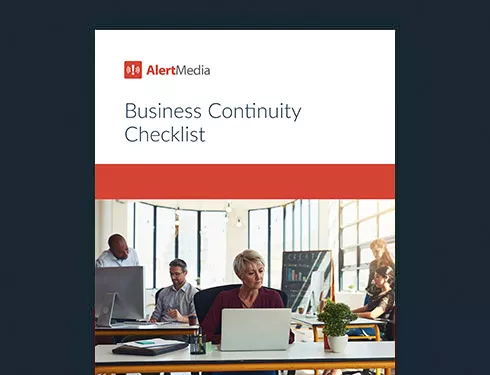
ISO 22301 Checklist: Maintain Business Continuity Management Compliance
Improve operational resilience, manage risk, and enhance your safety culture, all with a comprehensive audit checklist for business continuity management compliance.

How prepared would you be if a bomb went off outside your office this weekend? Even if your employees escaped unharmed and your property undamaged, we’re guessing the incident would affect your operations, at the very least,
Liberty Mutual Insurance experienced this exact scenario in the wake of the Boston Marathon bombings. “Our team was onsite the next morning, and we set up an emergency command center,” said Ashley Goosman, Risk Manager of Business Continuity & Crisis Management Specialist at Liberty Mutual. “We couldn’t get into the offices where my team was typically located because it was part of the crime scene. So, we had to improvise, and we were in a conference center on our main campus across the street.”
Being able to adapt quickly takes practice and planning, even when you can’t foresee every possible contingency. Juggling the many business continuity challenges can seem daunting, but you don’t need to reinvent the wheel to address them.
ISO 22301 provides a framework for security, resilience, and business continuity. So how can you maintain compliance with this standard at your company? Read on as we explore ISO 22301 and go through an audit checklist to ensure your organization can survive and thrive in any scenario.
Business Continuity Checklist
What Is ISO 22301?
Developed by the International Organization for Standardization (ISO), ISO 22301 is a standard for establishing business continuity management systems (BCMS). The standard lays out a framework for organizations to plan, implement, and maintain a BCMS—so companies can deal with disruptive incidents and formalize their resilience management efforts. In addition to covering BCMS controls, it serves as a business continuity plan (BCP) ISO standard.
ISO 22301, first released in 2012 and then updated minorly in 2019 (ISO 22301:2019), set the standard for business continuity and resilience. Unlike industry-specific standards, ISO 22301 is flexible and applies to companies of any size or type, though some requirements apply only to certain businesses.
What is a business continuity management system?
If the term “management system” makes you think of complex software, you’re not alone. But a business continuity management system is simply a set of processes that bring together different parts of a company’s business continuity plan.
Some of the key pieces include:
- A business continuity policy with scope and objectives for keeping operations running
- Risk assessment and management policies
- A business impact analysis (BIA) detailing continuity requirements
- Emergency response plans, such as evacuation routes and active shooter policies
- Communication plans, including policies on how to segment employees for mass notifications
- Lists of key stakeholders who will handle emergencies
- An overview of your company’s supply chain and how it ties into business continuity
- Resources to manage an incident in case of infrastructure disruptions
- Workforce management plans, including essential roles and backup points of contact
- Recovery time objectives and plans to resume normal operations quickly
- Cybersecurity plans and integration with your information security management systems (ISMS)
Integrating with other ISO standards
Companies complying with ISO 22301 will often want to adhere to other related standards, such as:
ISO 22301 simplifies integrations by following Annex SL, the unified structure for all ISO system management standards. Once your company understands this structure, implementing other standards becomes easier.
Watch this step-by-step video to learn how to create and optimize a plan that ensures your operations continue running smoothly—no matter what.
Step-by-Step ISO 22301 Checklist
ISO 22301 contains 10 sections, or clauses. The first three clauses are strictly informational and lay the groundwork for the rest of the standard:
- Clause 1: Scope — Explains the purpose of ISO 22301 and how companies can use it to improve business continuity.
- Clause 2: Normative References — Every ISO management system standard lists essential documents for cross-referencing. However, ISO 22301 has none.
- Clause 3: Terms and Definitions — Provides a glossary of specialized terms and clear definitions for commonly used terms to avoid confusion.
The following seven clauses provide actionable steps for implementing ISO 22301. If your organization already follows some or all controls, use these sections as an internal ISO 22301 checklist (like an audit to see if you missed anything). Otherwise, treat them as a step-by-step guide for implementation.
Clause 4: Context
For a BCMS to work, it needs to address your business’s unique competencies and needs. Clause 4 defines the scope of your BCMS based on your organization’s context. Set the parameters by asking yourself exploratory questions, like:
- Who are the key internal and external stakeholders in business continuity?
- What business functions and outputs do you need to protect?
- What are the expectations for business continuity?
- Do you have legal or regulatory requirements to address?
- Is your BIA up-to-date with the state of your company?
Clause 5: Leadership
ISO 22301 codifies the concept of company-wide buy-in, which is a foundational component of operational resilience. At this stage, top management needs to:
- Create a business continuity team responsible for implementing the complete ISO 22301 controls list
- Develop roles with clear responsibilities and authority to undertake the implementation
- Provide interested parties with the resources they need on an ongoing basis
- Reinforce the importance of BCP ISO standard compliance through coordinated communication and ongoing training
Clause 6: Planning
Clause 6 covers the development plans you’ll need for every aspect of the business continuity process. Understand and document these key items:
- A thorough risk assessment
- Measurable business continuity objectives and legal or regulatory requirements
- An accounting of your business operations and what defines acceptable downtime
- Reference documents such as a business continuity policy, business continuity strategy, your BIA, etc.
- Any prerequisites that need to exist in order for your plan to be effective
- Clear definition of roles and responsibilities for activating the plans, urgent purchases, crisis communications, etc.
- Disaster recovery plans, including locations, transportation, incident response, and plan activation/deactivation protocols
Planning for both immediate response and full recovery is an ongoing process. By working through different scenarios, you’ll uncover additional factors to address.
Clause 7: Support
Business continuity teams will need organization-wide support to implement their plans effectively. While specific needs vary by company, common areas include:
- IT resources to manage risks like network outages or damage to key technology
- Communication teams to create messaging strategies and train with your company’s two-way communication platform
- Employee training to educate staff on continuity plans and provide documentation
- Automation opportunities to reduce human error and speed up the response process
Clause 8: Operation
Using the resources you’ve been collecting, it’s time to turn plans into action. Clause 8 covers the development and implementation of your BCMS.
In this stage, you should cover the following:
- Execute, track, and document the processes that make up your BCMS
- Review your business impact analysis to map out recovery timeline objectives
- Define “recovery” in the context of your business operations
- Develop business continuity strategies to minimize risk and meet your recovery objectives
- Assess how your BCMS supports external stakeholders, such as clients and vendors, to ensure their needs are met
Use version control to track changes and maintain the accuracy of your BCMS, but also prepare to share it in different formats across the entire organization. For example, leadership may want to see presentations showing core strategies and business impact. Meanwhile, key personnel for managing emergencies will need thorough training and reference materials.
Clause 9: Performance evaluation
You can’t manage a process if you can’t measure it. But remember, how you measure is relative to your situation. For example, consider the key metric “maximum allowable downtime” (MAD). If a national restaurant chain is closed for 24 hours, it would be inconvenient. But if an international bank were offline for a full day, it could pose serious risks to the global economy.
Before judging your performance, begin by clearly defining what “success” and “failure” look like for your continuity plans—this is crucial for measuring the plan’s effectiveness.
Clause 9 calls for a formal evaluation process, which includes the following steps:
- Establish performance indicators and metrics that are aligned with the organization’s objectives, targets, and requirements.
- Employ various methods for measuring and analyzing these metrics, such as surveys, interviews, and audits.
- Use data and feedback to identify areas for improvement
- Schedule regular management reviews of audit results
Clause 10: Improvement
To ensure business continuity, treat planning as an ongoing cycle instead of a one-time task. With this in mind, the final step encourages safety leaders to step back to review and analyze outcomes.
The final step of ISO 22301 outlines a formal process to assess continuity efforts, document the evaluations, and implement continual improvements:
- Build a team responsible for measuring and documenting BCMS performance
- Monitor your BCMS by performing internal audits, tracking data and KPIs, and reviewing incident reports
- Analyze the output of monitoring, looking especially for places to improve or deviations from ISO 22301 guidelines
- Implement corrective and preventive measures that improve how your BCMS protects your organization
- Follow up on all changes to ensure they have the intended outcome
- Embed continual improvement in your company’s safety culture—one team may be responsible, but everyone plays a part
In a real-life example, Liberty Mutual found ways to improve its business continuity communication after the Boston Marathon bombing. “Many of us had been trained or come from an emergency management background, and our style of messaging is very direct,” Goosman noted. “We got feedback…after that event, employees wanted richer and more information.”
Their initial crisis response focused on managing and supporting their workforce throughout operational disarray. Based on this feedback, Liberty Mutual was able to refine its communication strategy and improve its business continuity management system.
Tips for Maintaining ISO 22301 Compliance
While the initial implementation phase does much of the heavy lifting, you’ll still need to maintain compliance with ISO 22301. Keep your BCMS and supporting documentation up to date, even as your company evolves. You may need to adjust your BCMS based on:
- New locations or staffing changes
- Adjustments to emergency response team responsibilities
- Technology updates that impact business continuity plans
- Operational shifts that change response and recovery timelines
Maintaining compliance is easier when everyone works together. So, create a team-wide commitment to continuous improvement. In practice, this means regularly testing your business continuity solutions and procedures and finding ways to improve.
If you need to activate your plans during an emergency, learning from the outcome is vital. After recovery, review everything that happened to identify areas for improvement, to shape a better and safer approach for the future.
Quick Overview of the ISO 22301 Certification Process
Not all companies implementing ISO 22301 need to seek certification. However, some industries, like healthcare, energy, and transportation, have legal certification requirements. For other organizations, seeking certification can provide internal peace of mind and serve as a selling point for customers.
There are three major steps in the certification process:
Choosing a certification body
ISO develops and publishes standards, but they don’t test or certify for compliance. Instead, private, third-party companies offer certification based on ISO standards.
Many organizations will seek accreditation to prove they’re following the appropriate guidelines. When looking for a certification body, we recommend consulting the International Accreditation Forum to vet the companies’ reputations.
Maintaining ISO 22301 certification
ISO 22301 certifications are valid for three years. In the first two years, you must complete surveillance audits, which are less intense than the initial approval but ensure compliance with ISO 22301. At the end of the third year, you’ll undergo a re-certification audit. If the audit finds any issues, you’ll have the chance to address them and keep your certification.
The ISO 22301 audit checklist
Certification bodies can set their own process—but many follow the same structure: The process often begins with a pre-certification check, including an optional gap analysis. The certification body will review your company’s documentation and implementation, then make any recommendations for adjustment.
The formal audit process involves two steps:
- A review of your business continuity management system and documentation
- An assessment of the ISO 22301 implementation and organizational controls to ensure it’s working as intended
If your company fails either step, you’ll have to repeat the process and pay for another audit.
Benefits of ISO 22301 Implementation
Maintaining ISO 22301 compliance not only prepares your company to handle operational threats but also offers several added benefits.
Minimize downtime and disruptions
In today’s economy, even minor downtime can lead to huge financial losses. Investing in ISO 22301 compliance protects your operations from downtime. It ensures that when there are unavoidable disruptions, you can get back up and running as quickly as possible.
Maintain legal and regulatory compliance
For many industries, ISO 22301 compliance isn’t just nice to have—it’s a requirement. Specifically, any businesses considered essential to the public good, such as transportation, healthcare, and energy, will be legally required to ensure continuity. Failing to comply could mean heavy fines, suspension of licenses, and lengthy disruptions to company operations.
Improve organizational resilience
Building business resilience means preparing for the unexpected. While business continuity focuses on getting through specific events like natural disasters, business resilience strengthens your ability to handle unforeseen challenges, which in turn strengthens the organization as a whole.
For example, a finance company preparing for disasters might set up remote data centers and backup networks. These same measures would also help in cases like a severed network or a minor cyberattack, boosting overall resilience over time.
Enhance your safety culture
Employees, vendors, clients, and shareholders all depend on your company’s safe and smooth operations. Being prepared for emergencies and organizational disruptions is a key component of safety culture. When your whole company buys in, you can count on your team to protect themselves, each other, and your company’s operations.
Following an international standard sends a strong message that you’re committed to business continuity. And when emergencies do arise, your teams will feel confident following their roles in restoring or preserving operations.
Maximize Business Continuity with a Template for Best Practices
Preparing your company to handle a wide range of threats can feel overwhelming. One day it might be a tornado; the next, an intruder at a nearby business. Your organization and its people depend on your readiness.
The BCP ISO standard helps by offering a clear process and an internationally-vetted framework for minimizing disruptions. By following the ISO 22301 checklist and implementing the standard, you’re not just checking boxes—you’re building a resilient foundation that ensures your company is ready for whatever comes next.





